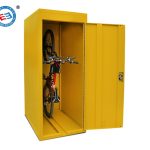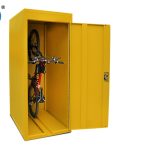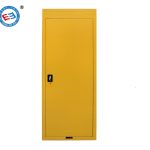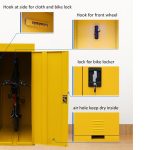When it comes to selecting the best bike locker, the material it is made from plays a significant role in determining its durability, security, and overall performance. The three most common materials used for bike lockers are steel, plastic, and wood, each with its own set of advantages and drawbacks. However, when you compare them head-to-head, steel stands out as the superior choice. Let’s dive into why steel bike lockers are often the best option for securing your bike and ensuring long-term use.
Multi-faceted comparison of bicycle lockers materials
1. Strength and Durability
Steel:
Steel bike lockers are known for their exceptional strength and durability. Steel is a tough material that can withstand significant force, making it highly resistant to break-ins, tampering, and the elements. Whether it’s a heavy impact, extreme weather conditions, or rough handling, steel bike lockers can endure it all. This makes them ideal for outdoor locations or public spaces where lockers may be exposed to physical damage.
Plastic:
Plastic bike lockers, on the other hand, while lightweight and inexpensive, are not as strong or durable as steel. Although plastic bike lockers can handle light use and resist rust, they are prone to cracking, warping, or even breaking when subjected to physical impact. They offer little resistance to vandalism and theft, which makes them a less reliable choice in high-security areas.
Wooden:
Wooden bike lockers are typically used for aesthetic purposes, offering a natural, rustic look. However, wood lacks the inherent strength of steel and can deteriorate over time due to exposure to weather conditions, pests, and moisture. Wood can also warp or crack, making it less ideal for areas with heavy use or exposure to the elements.
Verdict: Steel bike lockers win hands down when it comes to durability and strength. They offer superior protection for your bike and can withstand a variety of adverse conditions.
2. Security
Steel:
The primary reason people choose steel bike lockers is for their security. Steel bike lockers come equipped with robust locking mechanisms that can deter even the most determined thieves. The strength of the material itself acts as a deterrent, making it difficult to break into or tamper with. Steel bike lockers can also be outfitted with high-quality locks, such as combination locks, key-operated locks, or even electronic locks, enhancing the level of security.
Plastic:
Plastic bike lockers typically have weak locks, which offer minimal protection against theft. They are often easy to force open, and the material itself does not provide the same level of security as steel. Thieves can often bypass plastic locks with relative ease.
Wooden:
Wooden bike lockers can be more secure than plastic in terms of structure, but still fall short compared to steel. They are often vulnerable to break-ins due to their weaker material, and the locking mechanisms used in wooden bike lockers are typically not as strong as those found in steel bike lockers.
Verdict: Steel bike lockers provide the highest level of security, making them the best option for protecting your bike against theft.
3. Weather Resistance
Steel:
Steel bike lockers, especially those made from stainless steel or powder-coated steel, are highly resistant to the elements. They won’t rust or corrode as easily as other materials when exposed to rain, snow, or humidity. Additionally, steel can be easily maintained with occasional cleaning and a protective coat to prevent wear over time.
Plastic:
Plastic bike lockers offer some resistance to moisture and won’t rust, but they can still degrade under prolonged exposure to sunlight. UV rays can cause plastic to become brittle over time, and while they may be resistant to rain, they can crack or warp in cold temperatures.
Wooden:
Wood is highly susceptible to moisture, which can cause it to rot, warp, or develop mold. Wooden bike lockers require more maintenance to keep them looking good and functional, especially if they’re used in outdoor or exposed environments.
Verdict: Steel bike lockers provide the best weather resistance and will continue to perform well over the years, even in challenging weather conditions.
4. Cost and Value for Money
Steel:
While steel bike lockers can be more expensive upfront, they provide long-term value due to their durability and security. They require less maintenance over time and offer superior protection, making them a wise investment for locations where security is a top priority. The longevity of steel bike lockers means they won’t need frequent replacements, saving money in the long run.
Plastic:
Plastic bicycle lockers are usually the least expensive option, which makes them attractive for people on a budget. However, the lower cost comes at the expense of quality, security, and durability. Plastic lockers may need to be replaced more often, leading to higher long-term costs.
Wooden:
Wooden bicycle lockers fall in the middle range of cost but are often higher-maintenance. They may require regular treatments to maintain their appearance and structure, especially in outdoor or humid conditions. Additionally, they can be prone to wear and tear, meaning they might not offer the same long-term value as steel lockers.
Verdict: While plastic may seem more affordable initially, steel bike lockers offer the best value for money over time due to their long-lasting durability and minimal maintenance needs.
5. Aesthetic Appeal
Steel:
Steel bike lockers have a sleek, modern appearance that is often associated with commercial or urban environments. While not as visually appealing as wooden lockers, steel lockers can still be designed to blend into most environments. Their clean, minimalist look can complement modern architecture and is often chosen for functional rather than decorative purposes.
Plastic:
Plastic lockers are typically basic in design, with a utilitarian look. They are not known for their aesthetic appeal and may not add much to the visual appeal of a space.
Wooden:
Wooden lockers are the most aesthetically pleasing, offering a natural, warm look. They are ideal for locations where design and atmosphere are important, such as parks, resorts, or luxury residential buildings. However, their aesthetic appeal often comes with a trade-off in durability and security.
Verdict: While wooden lockers may offer the best appearance, steel lockers are more versatile and provide a better balance of form and function.
Conclusion: Why Steel Bike Lockers Are the Superior Choice
In the battle of steel vs. plastic vs. wooden bike lockers, steel comes out on top as the superior choice for most users. Its unmatched strength, security, and weather resistance make it ideal for securing your bike in any environment. While plastic lockers are cheaper and wooden lockers are more aesthetically pleasing, they don’t offer the same level of protection, durability, or long-term value as steel lockers.
If you’re looking for a locker that will keep your bike safe, withstand the elements, and last for years, a steel bike locker is undoubtedly the best investment. Whether you need it for public spaces, outdoor facilities, or commercial buildings, steel lockers provide the perfect combination of strength, security, and reliability.





